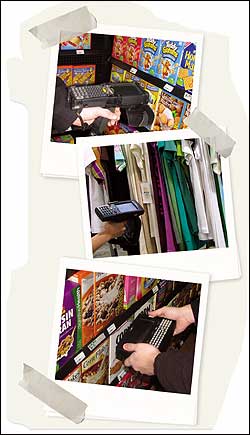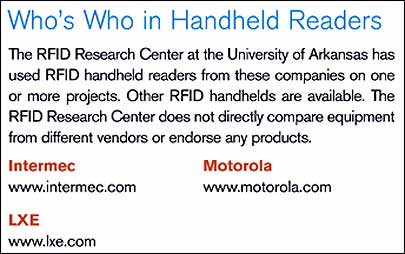Recently, the emphasis on item-level tagging in the apparel and footwear industry has accelerated the need for and development of RFID handheld readers. Numerous retailers—including New Balance in the United States, Falabella in Latin America, Marks & Spencer in the United Kingdom, the Metro Group’s Galeria Kaufhof in Germany, and Mitsukoshi in Tokyo—are piloting or deploying item-level tagging in stores to improve sales and customer service.
Employees are using RFID handheld readers to conduct periodic inventory checks of tagged items, which can reduce out-of-stocks. They are also using handheld readers to locate misplaced items on store shelves and help shoppers find items in the right sizes and colors. Maskyelin, an eco-friendly men’s clothing store in King of Prussia, Pa., even plans to arm its store-floor sales staff with handheld readers that act as point-of-sale devices for purchasing items without a cash register.
For the past year, the RFID Research Center at the University of Arkansas has been conducting an ongoing study—sponsored by the Voluntary Interindustry Commerce Solutions Association (VICS) and the Council of Supply Chain Management Professionals (CSCMP)—to investigate the technical feasibility and return on investment for RFID at the item level. The use of RFID handheld readers is a major part of this investigation.
Since the center began its study, the form and functionality of handhelds has changed and matured. This lab report examines three different RFID handheld readers that the lab used regularly: the Intermec IP4, Motorola MC9090 and LXE MX3X.
Similarities and Differences
All RFID handheld readers have two main components: hardware and software. The hardware comprises a keyboard (all three models come with an optional touch screen), a display (mono in older models, color in all new models), a central processing unit (CPU), memory and a removable power supply. All three handhelds also have a bar-code scanner to facilitate the transition from bar-code to RFID technology. The software consists of an operating system and applications.
The Intermec IP4, Motorola MC9090 and LXE MX3X weigh about 37 ounces, 35 ounces and 38 ounces, respectively. All three handhelds have a rugged design, with bodies made from polycarbonate plastics. This is important because they can withstand being dropped from varying heights—which, we’ve found, is a very likely occurrence in the work environment. The Intermec and Motorola devices have a pistol-grip design. The LXE reader resembles a flat, wide PDA and is held on both sides of the screen, like a portable game device. The LXE also includes slots that allow it to be snapped onto a vehicle or a stand to double as a mounted mobile reader.At the heart of any handheld is the CPU, which typically clocks in at several hundred megahertz. As with full-fledged computers, CPU speeds will continue to increase, facilitating better support for a more interactive user interface that can include, for example, product images or audio cues.
The RFID antenna on a handheld is typically directional, producing a forward-facing electromagnetic field that’s usually a 70-degree cone. The LXE MX3X has an internal circular antenna, the Intermec IP4 has a detachable external antenna, and the Motorola MC9090 has a specially designed curved linear antenna. A circular polarized antenna is less sensitive to tag orientation, but generally does not penetrate as well as a linear antenna. All manufacturers currently tune their antennas for tag densities and read ranges for which handhelds are frequently used.
All three handhelds come with a docking bay that both recharges the removable power supply and facilitates download of collected data to a computer or server. Battery life ranges from about six to 10 hours per charge, depending on use. All three devices provide wireless LAN communications capability, which facilitates real-time data exchange because there’s no need for the handheld to be docked in order to download its collected data. As with most static readers, handhelds have the ability to cache read information before sending it back across the network.
Any of the currently available commercial and noncommercial operating systems—including Microsoft Windows CE, Mac OS and various flavors of Linux—could theoretically be loaded onto the handhelds. But all three readers are currently sold preloaded with Windows CE and integrate well into a Windows-based network or RFID software control system.
All three devices we examined came loaded with applications written by either the manufacturer or a third-party software provider. But end users are encouraged to write their own software or work with a third-party middleware or control software company to properly address the environment in which the handheld will be used.Ergonomics
From our research, as well as from feedback from handheld users in the field, ergonomics has turned out to be an important issue. The problem is that with linear antenna handhelds, employees must wave the device, which weighs roughly 2 pounds, to generate an electromagnetic field that will read tags regardless of tag orientation. And swinging that weight repeatedly over the course of a typical workday causes wrist strain.
Generally, the handheld manuals incorporate best practices and instructions, based on the use of existing bar-code handhelds, on how to use RF-enabled handhelds for best read rates and less fatigue. But how employees actually use handhelds depends on what’s most comfortable, as well as on their physical build. And even if employees try to follow best practices, they gradually stop trying to swing the handhelds properly, instead working in ways that conserve energy. We’ve found that after as little as 30 minutes of continuous use, even the biggest and strongest workers begin to feel the strain on their wrists and arms.
Another problem is the fatigue that occurs from repeated scanning motions. Because of the size and weight of the required RF antennas attached to handheld readers, it is very difficult to perfectly balance the units for all users to best alleviate strain and fatigue. All handheld manufacturers have assured us that future devices—especially the pistol-grip readers—will emphasize proper balance and ergonomic factors.
For now, staff training is recommended to mitigate ergonomics issues, and to get the best read rates. In addition to reinforcing best practices for swinging handhelds, companies should familiarize employees with a basic working understanding of RFID technology. Topics should include why tag orientation can make a difference, why dead zones occur in read fields, and why there is an optimum read range. Providing employees with knowledge of how a technology works allows them to apply more initiative and creativity to solve the problems that inevitably crop up in the work environment; for example, they should know how to properly orient the reader with respect to the tag to get the best reads, and understand tag read ranges and densities to quickly deduce exactly which tags in a large population are currently being read.From Handhelds to Wearables
As the move to item-level RFID continues to accelerate, it will drive the need for handheld readers with different forms and increased functionality. We expect to see smaller and faster devices, not unlike the miniaturization of digital music players and palmtop computers. Advances in solid-state memory are enabling more memory to be packed into smaller devices.
Major chip designers are routinely releasing smaller and faster processors. In fact, there has already been a major miniaturization design focus specifically on UHF RFID devices. Intel’s new UHF RFID Transceiver R1000 chip, which incorporates most of the discrete elements used in a reader module on a single integrated circuit, promises to improve computing power while reducing the size and cost of readers.
As handhelds get smaller and lighter, mobile RFID readers may need a new moniker. That’s because these devices could be designed to be worn on belts, slipped into pockets, or integrated into gloves or the fabric of smocks or vests.
The Benefits of Handheld Readers
As part of an ongoing study sponsored by the Voluntary Interindustry Commerce Solutions Association (VICS) and the Council of Supply Chain Management Professionals (CSCMP), the RFID Research Center at the University of Arkansas has identified several benefits of using handheld readers.
Improving inventory: RFID handheld readers can significantly reduce the time it takes for employees to inventory items in a major department store. Say, for example, the men’s department has several thousand pieces of clothing, including shirts, slacks and ties. With a bar-code reader, it takes 9 minutes to get an accurate inventory of 100 items. But if each piece of clothing has a passive UHF RFID tag, with an RFID handheld reader it takes just 7 seconds to inventory those same 100 items.
Re-encoding tags in the field: Handhelds are often used for verification—for example, sweeping a pallet to make sure all case tags are present before applying the pallet label. During verification, it’s not uncommon to find tags that have been unintentionally miscoded. A handheld reader can be used to quickly re-encode the tags with the correct information so the tagged cases don’t have to be sent back to the location where the tags were initially applied. (This function is so easy to perform and useful to us in the lab that we often use handhelds to encode tags.) Of course, the handheld user should be authorized to re-encode tags to ensure they are not changed accidentally.
Finding individual products: Many RFID-enabled handhelds are equipped with a “finder” application that allows the user to specify a particular tag ID or product. As the user scans items in inventory, the handheld searches for the tag in its read field and beeps faster or louder as the user gets closer to the tagged item. There are many uses for this function—say, finding a case of expensive watches that’s fallen behind a pallet, locating cat food that isn’t readily visible in the stockroom of a store, or even singling out an individual item from a large group.
Caleb Brantley is a senior member of the testing and research staff at the University of Arkansas’ RFID Research Center, specializing in mobile and handheld technology. Mambwe Mumba is an RF field engineer at the RFID Research Center.




